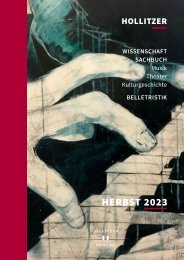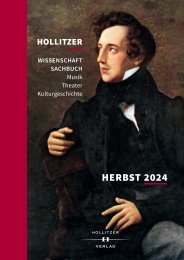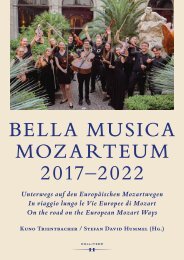Create successful ePaper yourself
Turn your PDF publications into a flip-book with our unique Google optimized e-Paper software.
Musical Documentation of a “Forgotten Century” and Beyond<br />
celebrations of Berlioz’s birth, explores French attitudes toward the composer<br />
across more than a century. Catherine Massip explores Berlioz’s relationship<br />
to the town of Baden-Baden at the intersection of iconography and the<br />
nineteenth-century press. More broadly, music in France is explored in four<br />
papers: Joost van Gemert explores the transnational reaction to nineteenthcentury<br />
debates concerning the use of Gregorian chant in the French church.<br />
Allan Atlas uncovers two families in Paris and Brussels who performed upon,<br />
and promoted, the English concertina. Ralph Locke writes an appreciation of<br />
opérette via a recent recording of Andre Messager’s delightful Les p’tites Michu.<br />
John Roberts explores the compositional history of, and critical reaction to,<br />
the lesser-known Grands Opéras of Charles Gounod. Relating to both French<br />
musical bibliography and the R-projects, Jennifer Ward explores Marie Bobillier’s<br />
central importance to Robert Eitner in his Quellen-Lexikon catalog,<br />
the forerunner to the Répertoire International des Sources Musicales (RISM).<br />
Bobillier, who wrote under the nom-de-plume Michel Brenet, demonstrated<br />
the problems faced by female music historians and bibliographers in the early<br />
twentieth century. Finally, reflecting Robert’s work on Giuseppe Verdi, Peter<br />
Sühring analyses Verdi’s sacred compositions, a lesser-explored area of Verdi’s<br />
oeuvre.<br />
Music iconography is explored in five papers, beginning with two on the<br />
scholarly history of the discipline. Zdravko Blažeković provides a history of the<br />
foundation and early years of the fellow R-project, the Répertoire International<br />
d’Iconographie Musicale (RIdIM). Florence Gétreau assesses the work of three<br />
founders of music iconography as a scholarly discipline in France. Luísa Cymbron<br />
provides us with a delightful exploration of visual depictions of sound<br />
transmission technologies in late-nineteenth century Lisbon. Frits Zwart explores<br />
the relationship between the conductors Willem Mengelberg and Leopold<br />
Stokowski via a photograph of Mengelberg leaving the cinema. Finally, Tatjana<br />
Marković analyses how sources—iconographical, textual, musical—define cultural<br />
memory through the publication of a single ballad.<br />
Jazz and popular music also make appearances. Reflecting Robert’s longstanding<br />
love of jazz, John Ehrenburg provides a reappraisal of pedagogical<br />
studies published in jazz periodicals, exploring the long-asked question of “how<br />
do you learn jazz?” Harkening back to Robert’s first published article, on Bob<br />
Dylan, Emile Wennekes muses on three cultural environments in which Robert<br />
is professionally and privately active: the United States, France, and the Netherlands,<br />
through three singer-songwriters within each national context.<br />
Finally, Barbara Dobbs Mackenzie offers us a glimpse into the “nanoniche”<br />
world of the R-project directors. As she astutely notes, directing an<br />
21














